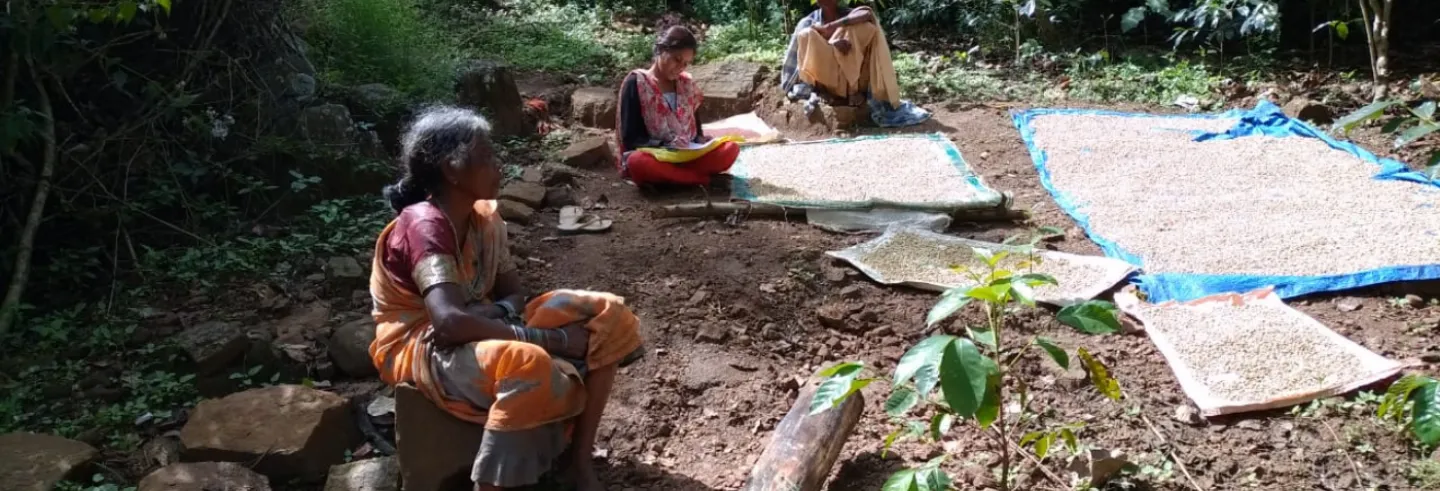At the 28th session of the Conference of the Parties (COP28) to the United Nations Framework Convention on Climate Change (UNFCCC) held in Dubai in December 2023, the software mogul turned philanthropist Bill Gates talked about how changing climactic conditions were a dangerous threat to human survival. His comments, and those of the speakers who followed, on the impact of climate change on nutrition were largely focused on the effect of extreme weather on agricultural systems, which could result in crop failures and thus affect nourishment.
The World Health Organization (WHO) estimates that more than five million deaths will occur in the next two decades as climate change affects health. These links between climate change and health received global recognition during the COP28 discussions, which carved out, in collaboration with the WHO, a health agenda that focused on “lift(ing) the political profile of the climate-health nexus, and mainstreaming health in the global climate change agenda”. It resolved to transform global food and agriculture systems that mass produce cheap foods, hiding their true environmental, social and health costs (estimated at a staggering US$10 trillion annually by the Food and Agriculture Organization’s “State of Food and Agriculture Report 2023”) in the form of water and soil pollution, greenhouse gas (GHG) emissions, and so on.
The practices of the Solega tribe in the Biligiri Rangaswamy Temple Tiger Reserve and Wildlife Sanctuary in southern Karnataka provide an example of the potential of traditional food systems to be climate resilient.
Heeding this call would require sustainable food system transitions, including reviving traditional food systems that are climate resilient and nature positive, while ensuring nutritional security to the vulnerable. Two vital questions to consider are: one, how are changes in the environment experienced locally? Two, what could be a possible way forward for the most affected communities?
The practices of the Solega tribe in the Biligiri Rangaswamy Temple (BRT) Tiger Reserve and Wildlife Sanctuary in southern Karnataka provide an example of the potential of traditional food systems to be climate resilient. They also offer solutions for low-carbon pathways to face agroecological changes that can profoundly impact dietary diversity and nutritional outcomes.
The Solegas are a forest-dwelling tribe concentrated largely in Chamarajanagar district of Karnataka. With a population estimated at around 40,000, they are legally recognised as a Scheduled Tribe. Historically, they practised shifting agriculture, cultivating ragi (finger millet). Their main source of income was the collection and sale of non-timber forest produce. More recently, there have been attempts by the government to mainstream the Solegas and extend their access to primary health centres and the public distribution system.
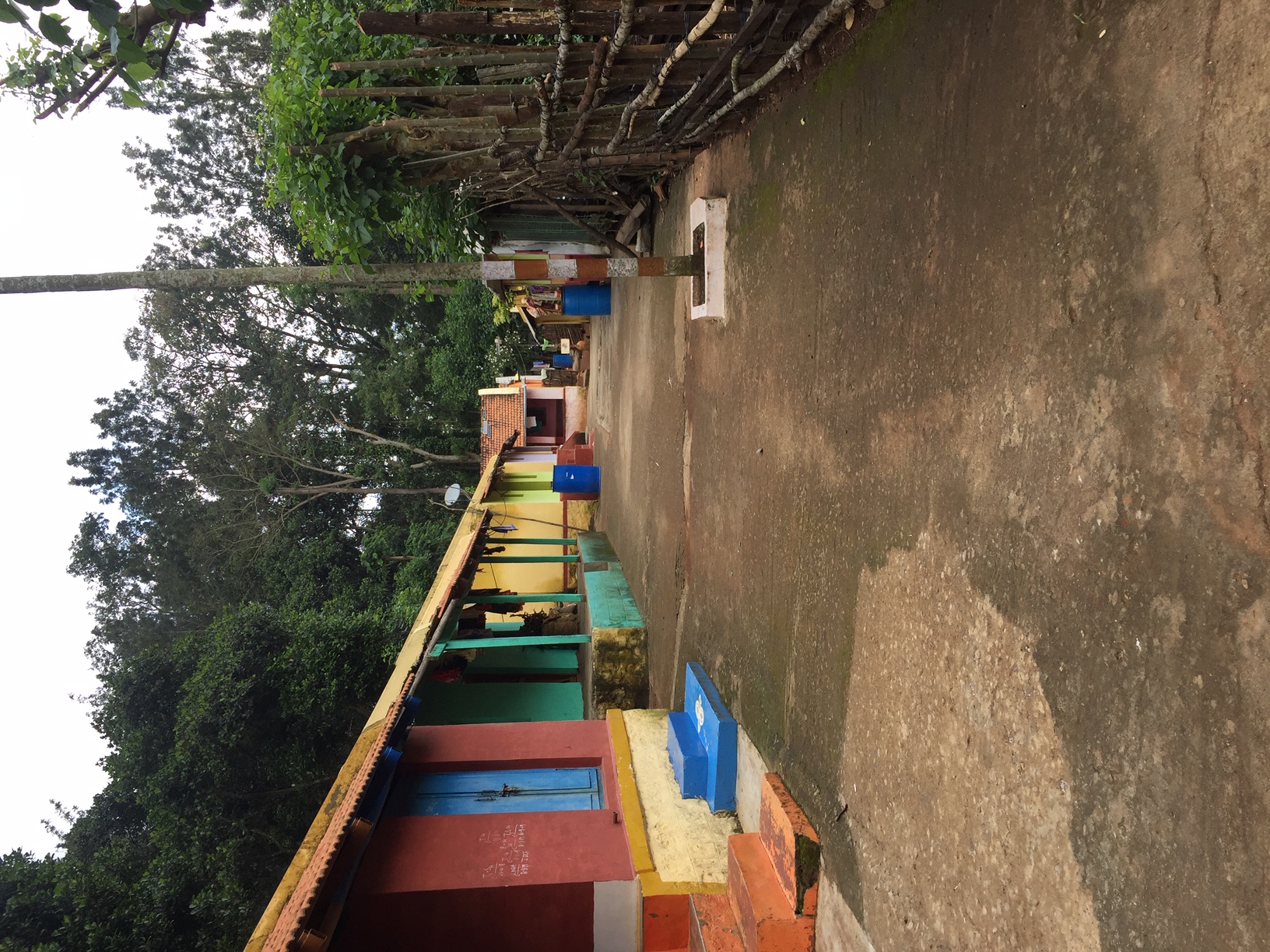
In 1974, the Solega lands in southern Karnataka were taken over to establish the Biligiri Rangaswamy Temple (BRT) Wildlife Sanctuary. Traditionally, the Solegas had access to a rich diversity of food, including a variety of yams and tubers, green leafy vegetables, fruit and berries, millets and other grains, milk and honey, and a range of different types of animal proteins. Following the establishment of the wildlife sanctuary, shifting cultivation was banned and the tribe was settled in podus (tribal hamlets) outside the sanctuary where they began practising settled agriculture. They have had some access to the forest, but this was severely restricted after the establishment of the BRT Tiger Reserve in 2011.
The concern for food availability has structured discussions around food justice, calling for programmes that enhance food availability for the most marginalised and vulnerable households…
Over time, subsistence farming has been slowly replaced by cash crops, primarily coffee, in wet areas at higher altitudes because of increasing damage to crops by wildlife. The change in the behaviour of wildlife has been triggered by changes in forest composition and quality (Mundoli et al. 2016).
The changing relationship of the Solegas with their forest home is central to the complex transformations that their food system is undergoing. At the heart of these changes are the ways in which national and state-level policies and laws have shaped how this community relates to and utilises forest produce.
Climate change and nutrition
The experience of the Solegas exemplifies the transformation of traditional food systems, which were the basis for the food and nutritional security many communities enjoyed for millennia. Since independence, India’s concern of ensuring food security for its growing population has played an important part in the political discourse. However, this discourse has so far largely been focused on the per capita availability of a designated number of calories per day.
The concern for food availability has structured discussions around food justice, calling for programmes that enhance food availability for the most marginalised and vulnerable households, and expand their access to an adequate daily calorific intake. Food policy in India so far does not address the issue of nutritional security as much as it focusses on hunger (Banik 2016). The consequences of this oversight are evident in data on nutritional status, especially of children and women.
According to the Global Nutrition Report (2022), India is on course to reaching childhood stunting targets, but off course for achieving childhood wasting targets, as well as anaemia targets for both women and children. According to the National Family Health Survey-5 (2019-2021), childhood stunting and wasting fell marginally between 2015–16 and 2019–21, to 35.5% from 38.4% and to 19.3% from 21% , respectively. However, anaemia amongst women aged between 15 and 49 years rose in the same period, to 57% from 53.1%, and amongst children more steeply, to 67.1% from 58.6%.
Since nutritional outcomes are closely related to health outcomes, their link to dietary adequacy and diversity needs to be carefully considered. Nutritional security is highly dependent on adequate access to and consumption of a diverse range of foods.
This is where the intricate relationship between climate change, agroecology, and traditional food systems gains salience. Food production is intricately linked to local agroecology (including biodiversity, forests, water, livestock, and ecological commons, all of which are immensely vulnerable to climate change impacts) and social practices (including caste, tenurial arrangements, labour practices, and the power dynamics of entrenched socio-economic relations). The intersection of these three components forms a complex web, which has profound implications for nutrition security.
Nutritional security
Traditional food systems, deeply rooted in local culture and practice, play a pivotal role in promoting nutritional security. These systems often incorporate time-tested agricultural techniques that are well-adapted to the local agroecology, including (where appropriate) the forest and its produce.
These include crop choices depending on weather fluctuations (for instance, growing short duration varieties if there is an increasing flood risk), multilayered and intercropped farming systems, crop rotations, soil and moisture conservation practices, conservation of seeds of traditional varieties, and wild food foraging. These have all been indigenous strategies for climate resilient agriculture. Such indigenous knowledge, passed down through generations, provide valuable insights into sustainable farming practices that could withstand the challenges posed by a changing climate.
The Solega practice of burning the forest floor in early summer helped in controlling pests and invasive species. This was banned following the Wildlife Protection Act, 1972 and the cascading impacts of this decision have been well documented.
One of the critical contributions of traditional farming practices is preserving biodiversity, contributing to a resilient and varied agricultural landscape. This biodiversity not only enhances the adaptability of agricultural systems but also serves as a buffer against the potential impacts of climate change on food production. All this while maintaining everyone’s nutritional balance.
The Solega practice of burning the forest floor (called taragu benki or litter fire) in early summer helped in controlling pests and invasive species. This was banned following the Wildlife Protection Act, 1972 and the cascading impacts of this have been well documented (Sundaram et al. 2012; Sundaram et al. 2015). In the absence of controlled burning, there was a regime shift in the forest ecosystem, and invasive species such as Lantana camara have proliferated, suppressing the growth of native grasses, tubers, bamboos, and fruit trees such as amla, that were a major source of income and supplementary nutrition.
As Lantana camara took over, it overwhelmed a range of wild foods both humans and animals consumed. The thick Lantana bushes also impede the movement of tribals within the forest, constraining their ability to gather whatever forest produce is still available.
Figure 1: Traditional Solega Food System in Transition
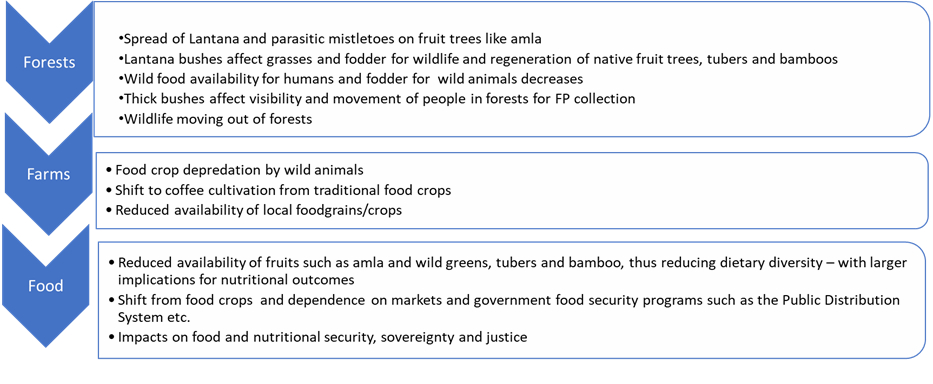
Forest conservation initiatives have also caused a huge increase in wildlife, which has spilled out of forests. Boars and elephants raid farms, resulting in widespread destruction of crops. As yields fell, farmers increasingly switched to cash crops such as coffee, which are less prone to wildlife depredation. Unlike other food crops such as ragi, coffee is not a preferred choice of wild animals. Besides, pepper is strategically trailed in coffee plantations to keep animals away.
The traditional multi-layered crop system of millets, cereals, pulses, vegetable, and oilseeds has been replaced by coffee and its companion plants such as pepper and silver oak. The agrobiodiversity of the region has been reduced.
Transformation of tradition
The combined changes in forests and farms cut off the supply of wild fruit and berries, green leafy vegetables, and tubers, mushrooms and bamboo shoots to the Solegas. State policies on food distribution concentrated on increased access to fine cereals such as rice and wheat. All this has drastically reduced dietary diversity and, by implication, nutritional security for the Solegas. In April 2021, we spoke with members of multiple households across nine Solega podus about their diets. The responses were telling.
Figure 2: Foods Consumed Then
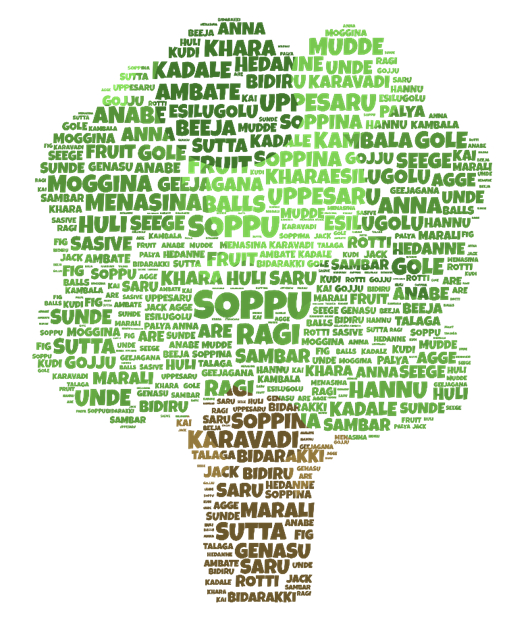
Figure 3: Foods Consumed Now
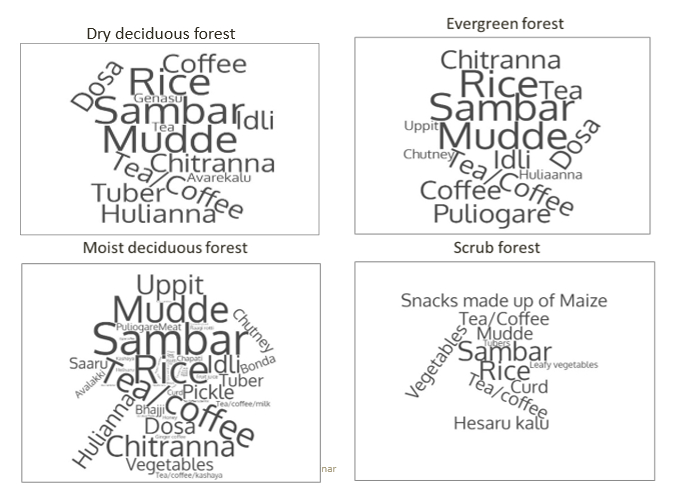
As the word clouds generated from the responses show, foods consumed in the past were more diverse compared with what is consumed now. Earlier, everything was mostly sourced from either the forest or their farmland and diets exhibited variations across forest types. Today there is a remarkable similarity in the foods consumed. Far fewer of the foods consumed now were part of the traditional diet of the Solegas. Rice-based foods like idli, dosa, chitranna (lemon rice), and hulianna (sambar rice) feature far more prominently now compared to ragi and roti earlier.
This reduced diversity is not limited to forest-reliant communities, but is also experienced across groups. In a study on the dietary diversity of primary school children aged 6 to 12 years in three 'mainstream' districts of Karnataka (Yadgir, Mandya, and Mysuru) similar patterns of dietary change were evident (Seshadri et al. 2016). After interviewing a group of grandmothers in these areas on changes in the composition of their daily diet, the researchers found that there has been a huge transformation over time.
Table 1: What We Ate Then and What We Eat Now
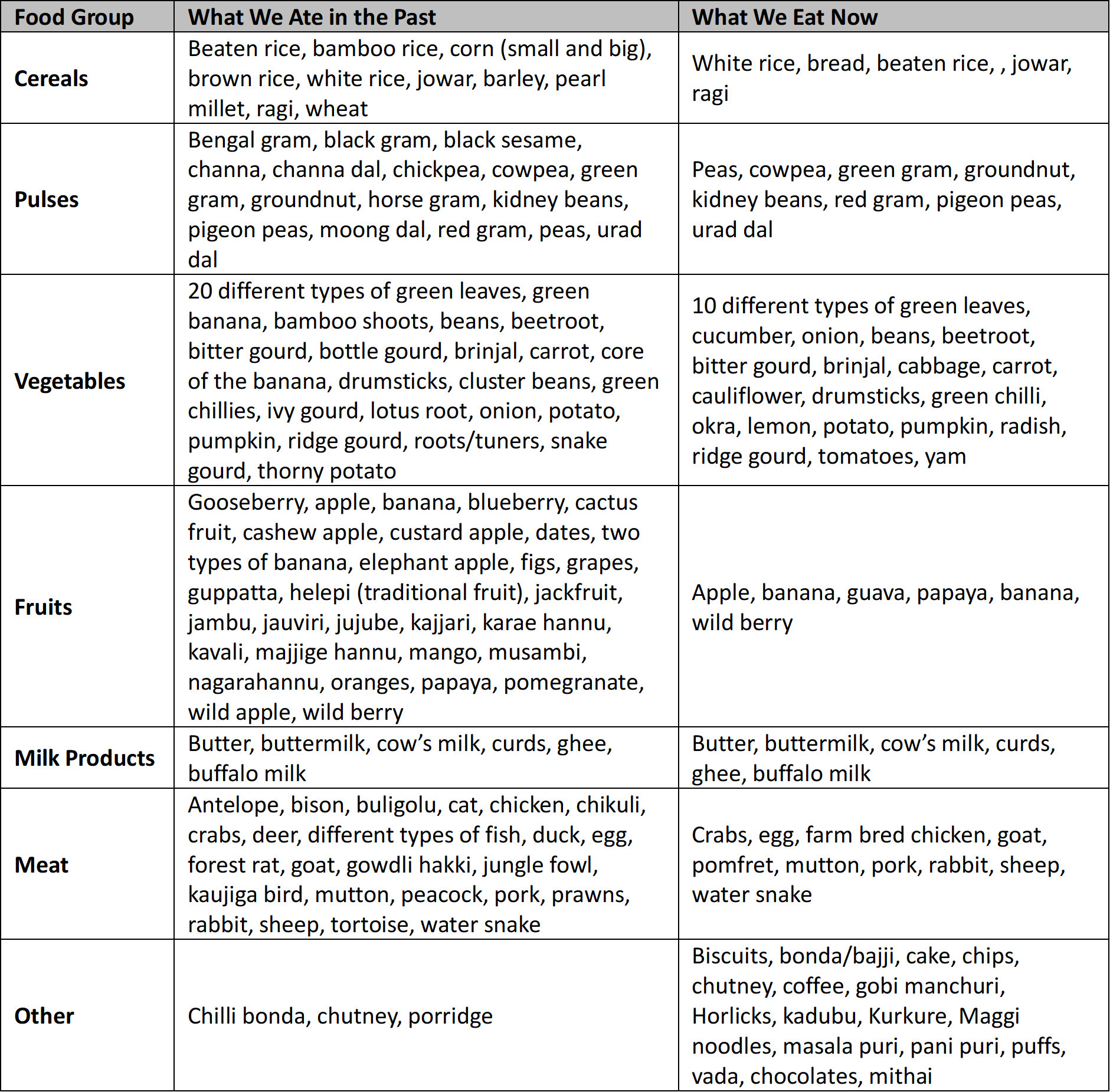
As is evident, each category shows a significant drop in diversity, some of which have serious nutritional impacts. The reduction in varieties of green leafy vegetables, for example, and the smaller range of meats available for consumption reflect shrinking availability, both due to agro-ecological changes and a curtailment of access to the traditional practices of foraging and hunting.
This has meant a greater reliance on the public distribution system, which provides a generous monthly allocation of rice per household, and the market, where other foods can be sourced, but at a price. There has also been a shift in food choices as a result of the greater contact of the Solegas with people of the plains as well as the media, which has exposed them to modern fast foods, which were never part of their traditional diet.
These factors combine to substantially impact the nutritional security and food sovereignty of the Solegas and other groups like them.
Enhancing resilience
Global leaders and policymakers, academics, community organisers, and others need to go beyond looking at the obvious impacts of climate change: agricultural productivity, crop failure and the threat to food production. Concerns around food security – and, by extension, food justice – are indeed critical.
But the imagination of policymakers and food-subsidy programmes is yet to extend to considerations of nutrition security, much less food sovereignty. Undernutrition looms discussions on maternal and child health, like preventing anaemia amongst pregnant women and adolescent girls by providing iron and folic acid supplements. Similarly, overnutrition or obesity is receiving increasing attention because of the rise in adult diabetes and hypertension. However, the link between these forms of malnutrition and a diverse, nutritious diet is yet to be recognised.
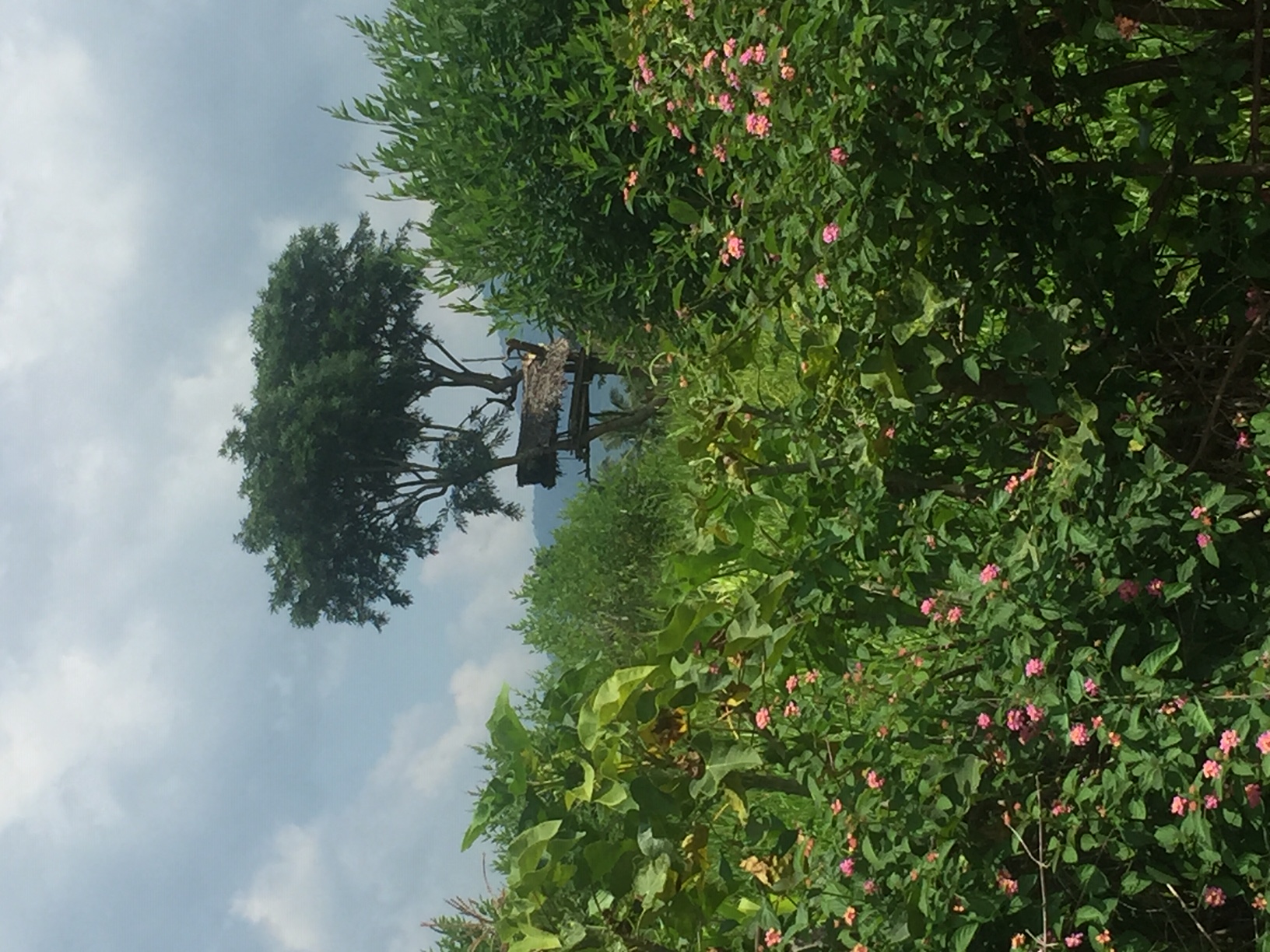
Traditional food systems, deeply embedded in local communities and contexts, offer hope as well as practical solutions that could contribute to the resilience and flourishing of both ecosystems and societies. Moreover, traditional knowledge enables farmers to adapt to changing conditions, such as altered planting seasons or shifts in precipitation patterns, ensuring the continuity of food production.
The diversity of crops and farming techniques inherent in traditional practices helps mitigate the risks associated with climate variability, while promoting nutritional security. Diversity is the key to resilience and traditional knowledge helps in maintaining diverse farming systems (multi-cropping, intercropping) that can better combat climate variability by buffering the risks associated with monocrops. If one crop fails, another one can help the farmer tide over the situation. Also, traditional knowledge can help decide on the right crop variety depending on climate variations. It can facilitate adaptive management in the face of climate uncertainties.
Beyond their ecological significance, traditional food systems are integral to cultural identities. The crops cultivated, the farming rituals observed, and the culinary traditions practised are often deeply intertwined with the cultural fabric of communities.
As climate change threatens the viability of a range of crops and farming practices, preserving traditional food systems becomes a way of safeguarding our cultural and natural heritage, promoting nutritional security, and preserving the rich tapestry of global dietary diversity.

